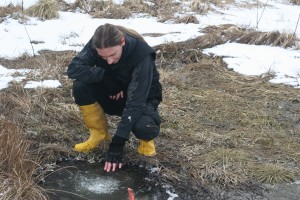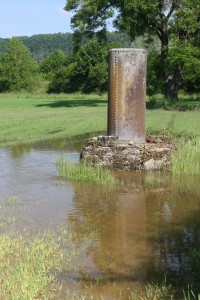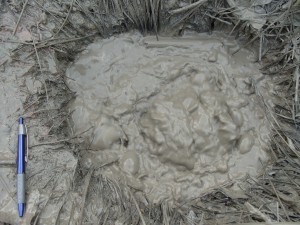17 December 2013
Former German mining site becomes laboratory for carbon dioxide storage research

Alexander Lübben samples carbon dioxide that seeps to the surface in Germany’s Upper Neckar Valley. Credit: Alexander Lübben
A local legend circulates in the Upper Neckar Valley in southeast Germany. It tells of a worker, a healthy, strong young man, who lay down one day beside the railroad tracks for a midday nap. The man never woke up, prompting speculation about his death that endures until today.
The worker, if he existed, probably died for the same reason the dead bodies of snails, birds and mice lay strewn on the site today: carbon dioxide suffocation.
The colorless, odorless gas bubbles to the surface, forming oozing mud puddles called mofettes. Heavier than air, they linger near the ground, smothering unwitting rodents as well as snoozing workers.

Carbon dioxide bubbles to the surface in this mofette in the Upper Neckar Valley. Credit: Alexander Lübben
Around 1900, the gas bounty attracted miners who sunk wells along the Neckar River to capture carbon dioxide for dry ice and mineral water. In 1995, the wells were capped, due in part to tightening environmental regulations, Alexander Lübben explained Thursday afternoon at the American Geophysical Union’s Fall Meeting in San Francisco.
Lübben, a geosciences graduate student at the University of Tübingen, was elated when he discovered the spot. It was a fitting natural laboratory to test carbon dioxide monitoring methods and track the ecological effects of long-term exposure to elevated carbon levels.
Increased interest in carbon capture and storage has led to the need for refined measurement methods and long-term analyses of carbon dioxide in the ground. Carbon capture and storage, or CCS, is a technique of pumping carbon dioxide from power plants or other industrial uses underground. The technique is not new, yet debate persists over the effects and extent of carbon dioxide leakage into the atmosphere, groundwater and soil.
Lübben and his colleagues inserted ground monitors in a 25-meter square plot in the Upper Neckar Valley. Some areas had carbon dioxide concentrations of nearly 90 percent, a level that withers nearby vegetation. He has also taken samples from local waterways and created a mofette by punching through the earth. The manmade mud puddle persisted, he said.

Abandoned wells dot the Upper Neckar Valley site, which is owned by a local nobleman. Credit: Alexander Lübben
Lübben plans to pursue other studies on the site examining the effects of precipitation and air pressure on carbon dioxide emissions and taking deeper samples to study concentrations in groundwater. He said the site could also be used to train workers sampling carbon dioxide.
The site is owned by a baron whose castle perches on a hill overlooking Lübben’s natural laboratory. Lübben thinks he’ll be amenable to ongoing studies in the area.
“He’s a nice nobleman,” Lübben said.
– Becky Bach is a science communication graduate student at UC Santa Cruz


 GeoSpace is a blog on Earth and space science, managed by AGU’s Public Information staff. The blog features posts by AGU writers and guest contributors on all sorts of relevant science topics, but with a focus on new research and geo and space sciences-related stories that are currently in the news.
GeoSpace is a blog on Earth and space science, managed by AGU’s Public Information staff. The blog features posts by AGU writers and guest contributors on all sorts of relevant science topics, but with a focus on new research and geo and space sciences-related stories that are currently in the news.